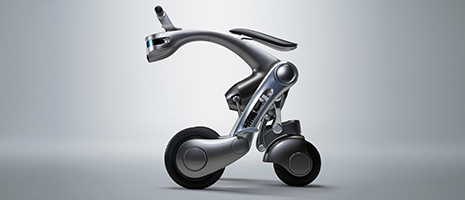Home > Highlighting JAPAN > Highlighting Japan September 2018 > Science & Technology
Highlighting JAPAN


Rideable Androids: Changing the Definition of Vehicles
A new type of robot called CanguRo is designed to serve as both a vehicle and a companion. Inside its simple frame, an AI and the world’s latest and greatest technology combine to assist and make emotional connections with people.
Developments in driving technology such as autonomous operation promise to eliminate the need for human drivers to control vehicles, which are simply becoming tools to bring people from point A to point B. But Takayuki Furuta, general manager of fuRo—the Future Robotics Technology Center, part of the world-renowned robotics program at the Chiba Institute of Technology—wanted to create an innovative vehicle that would radically alter the concept of vehicles. That is why he created CanguRo.
CanguRo is what is known as a RidRoid—a term that combines the words “ride” and “(and)roid.” CanguRo has handles like the ears of an animal. In its “Roid” mode, CanguRo moves to match your walking pace, and even turns into a cart for shopping and assists your daily routines. When you put the robot into Ride mode, its front wheel extends and the saddle rises so you can mount and ride it. The experience is less like driving and more like the robot and rider moving as one.
“The relationship we were trying to imagine was the ancient bond between humans and horses,” Furuta explains. “While horses can be ridden, they also form an emotional connection with and enjoy the trust of people. We’ve tried to develop a new type of connection between people and vehicles through CanguRo.”
Although CanguRo’s body looks simple, it incorporates many of the latest exclusive technologies fuRo has devised. One key technology is the in-wheel driving unit. While it looks like a normal wheel on the outside, the front wheel has a unique thin motor, gear and auto-driving system developed specifically for the robot.
In Ride mode, CanguRo becomes an extension of your body. Along with a bilateral control system installed on the steering handle, it uses an active lean system that detects your body weight and physical force, allowing it to move naturally in the direction you prefer, like skiing. The areas that you touch—such as the seat and handles—send out heartbeat-like pulses that allow the rider to remain aware of how fast he or she is traveling.
CanguRo can be summoned from a distance, a feat made possible by real-time automated mapping and CanguRo’s ability to determine its location. fuRo has been developing SLAM (simultaneous localization and mapping) technology for many years that allows simultaneous mapping. While SLAM is being developed in various areas of the technology sector, the processing power of fuRo’s SLAM technology is one of the best in the world. CanguRo is therefore able to safely move around while avoiding obstacles in spaces full of people and their unpredictable movements.
One of the robot’s features is an AI that makes the key technology behind the connectivity between people and CanguRo possible. “If it isn’t able to acknowledge its surroundings, CanguRo will not be able to serve as the user’s companion,” Furuta says. “That is where the AI comes in.” The AI will learn from the situations and scenes it encounters. For instance, if there is someone holding heavy objects, it will carry them. If someone collapses, it will call for assistance.
“Creating an innovative robot-vehicle and making it part of society is my job,” Furuta says, looking into a companionable future. “I’m trying to allow more people to use and experience CanguRo by offering the technology to companies and eventually putting it out onto the market. I’d like to create a positive environment through CanguRo by helping the elderly and communities.”
© 2009 Cabinet Office, Government of Japan







